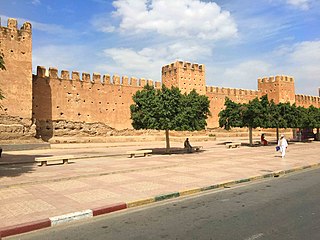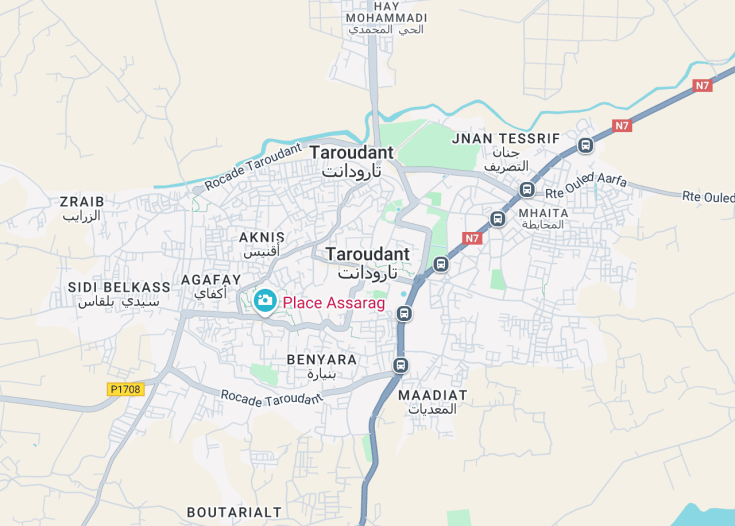Nestled in the Souss Valley between the High Atlas Mountains and the Anti-Atlas range, Taroudant is often referred to as the “Grandmother of Marrakech.” Known for its rich history and vibrant culture, this Moroccan city offers visitors a more tranquil alternative to the bustling tourist spots. Encircled by ancient walls, Taroudant is home to bustling souks, exquisite artisanal products, and traditional Moroccan architecture. It is a perfect destination for those interested in exploring the authentic Berber culture and historical sites away from the typical tourist paths.
For a unique experience, visit Taroudant in the early morning or late afternoon when the city’s colors and crowds are most vibrant and the light is ideal for photography.
Don’t miss exploring the local souks. These markets are less touristy than those in larger cities, offering a more genuine glimpse into the daily life and commerce of a Moroccan town.
Top things to do & see in Taroudant
Select the following sights and activities to discover best tickets and tours available in Taroudant.
Taroudant: Gateway to the Souss Valley
| Country | Morocco |
| Time in Taroudant | GMT-1 |
| Language spoken | Arabic and Tachelhit (Berber) |
| Population | 80,229 (source: latest available data from Morocco’s national statistics) |
| Currency | Moroccan Dirham (MAD, د.م) |
| Airports |
|
Taroudant, framed by high fortress walls and graced with the backdrop of the often snow-capped High Atlas Mountains, is a beguiling town steeped in rich history. Once an ancient Berber town, Taroudant has held onto its roots and offers a more subdued yet genuinely enchanting experience compared to the more bustling Moroccan cities. Often called ‘Little Marrakech,’ it showcases a slower pace of life where visitors can meander through labyrinthine souks, sip tea in the sun-soaked squares, and walk along its historic walls, offering a panoramic view of the town and its surroundings.
Distinctly known for its exquisite craftsmanship in jewellery and pottery, Taroudant also offers colorful tanneries and a thriving agricultural vicinity that produces an array of Moroccan staples. Historically, it was an essential trading center, pivotal in the routes across North Africa. Today, its blend of historical significance and cultural wealth makes it all the more alluring to those seeking to dive into the Morocco of yesteryears, with the comfort of less touristic hustle and bustle.
Where is Taroudant?
Taroudant is located in the Souss Valley in southern Morocco, surrounded by citrus groves and pomegranate fields.
Distances:
| Route | Distance by car | Time by car |
|---|---|---|
| Marrakech to Taroudant | 172 miles / 276 km | Approx. 3.5 hours |
| Agadir to Taroudant | 49 miles / 79 km | Approx. 1 hour |
| Casablanca to Taroudant | 338 miles / 544 km | Approx. 5.5 hours |
What is Taroudant famous for?
Renowned for its impressive ancient walls encompassing the city and its souks that offer traditional Moroccan goods, Taroudant is also celebrated for its rich history and agricultural importance.
History
Prehistory to Early Settlements
Archaeological evidence suggests that the area around Taroudant, located in Morocco’s fertile Souss Valley, was inhabited by Berber tribes since prehistoric times. These early inhabitants utilized the valley’s rich resources, and over the centuries, developed it into a thriving agricultural hub.
11th to 15th Century
The foundation of Taroudant is closely linked to the strategic movements of the Saadian dynasty in the 16th century, though the region itself had been significant much earlier. During Medieval times, it functioned as a key trade and caravan route connecting the Saharan trade networks with the northern cities of Morocco.
16th Century Mid: Rise of the Saadian Dynasty
In the mid-1500s, under the reign of the Saadian sultans Mohammed ash-Sheikh and Abdallah al-Ghalib, Taroudant became an important military base from which the Saadians organized their expeditions to consolidate power across Morocco. The city experienced a golden age with significant fortification and expansion.
17th to 19th Century: The Moroccan Dynastic Struggles
Following the decline of the Saadian dynasty, Taroudant saw fluctuating fortunes as control of Morocco oscillated among various ruling families. The city’s importance waned compared to the new imperial cities but remained a significant regional power in the Souss Valley.
20th Century to Present
The French colonial period marked a time of marginalization for Taroudant, overshadowed by other Moroccan cities integrated into the French economy. Post-independence, the city has revived its historical legacy, emphasizing cultural tourism and its rich historical architecture, drawing visitors globally interested in its preserved Moroccan heritage.
Visit Taroudant
Explore the Sights and Activities of Taroudant
Taroudant, often referred to as the “Grandmother of Marrakech,” invites visitors to explore its historical walls, vibrant souks, and tranquil atmosphere. Key attractions include:
- The ancient city walls, offering expansive views and a glimpse into the city’s formidable past.
- The bustling souks, such as Souk Arabi and Souk Berber, perfect for finding traditional Moroccan crafts and spices.
- Walking tours around the town to admire the traditional Moroccan architecture.
- Nearby excursions to the Atlas Mountains or the palm groves of Tioute.
Annual Festivals and Events
Taroudant hosts several cultural events through the year that celebrate its rich heritage and community spirit, including the popular Harvest Festival in September, where locals celebrate agricultural bounty with music, dance, and traditional foods.
Best Time to Visit Taroudant
The ideal time to visit Taroudant is from October to April when the weather is pleasantly mild, making it perfect for exploring the city and engaging in outdoor activities.
Is Taroudant Worth Visiting?
Taroudant is undoubtedly worth visiting for those interested in experiencing a less commercialized, yet deeply historic side of Morocco. This city offers a unique blend of rich cultural heritage with a laid-back atmosphere, set against the stunning backdrop of the Atlas Mountains. Whether you are a history buff, culture enthusiast, or simply looking to explore something new, Taroudant promises a memorable experience.










